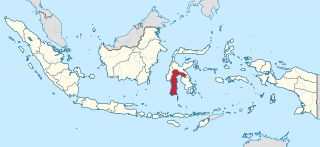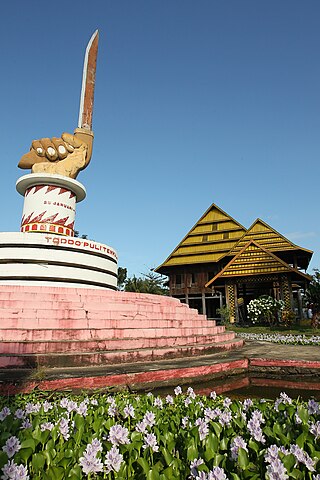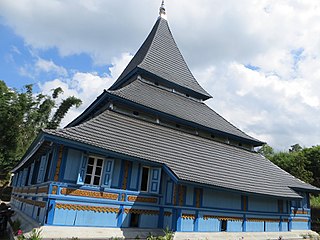
South Sulawesi is a province in the southern peninsula of Sulawesi, Indonesia. The Selayar Islands archipelago to the south of Sulawesi is also part of the province. The capital and largest city is Makassar. The province is bordered by Central Sulawesi and West Sulawesi to the north, the Gulf of Bone and Southeast Sulawesi to the east, Makassar Strait to the west, and Flores Sea to the south.

Istiqlal Mosque in Jakarta, Indonesia is the largest mosque in Southeast Asia and the ninth largest mosque in the world in terms of worshipper capacity. Built to commemorate Indonesian independence, this national mosque of Indonesia was named "Istiqlal", an Arabic word for "independence". The mosque was opened to the public on 22 February 1978. Within Jakarta, the mosque is positioned next to Merdeka Square, the Jakarta Cathedral (Catholic), and also of the Immanuel Church (Reformed).

The Kingdom of Luwu was a polity located in the northern part of the modern-day South Sulawesi province of Indonesia, on the island of Sulawesi. It is considered one of the earliest known Bugis kingdoms in Sulawesi, founded between the 10th and 14th century. However, recent archaeological research has challenged this idea.

Palopo or Kota Palopo is a city located in South Sulawesi, Indonesia, and the second-largest city in the province. Until it acquired its autonomy on 10 April 2002, Palopo was the capital of Luwu Regency. The area of the city is 247.52 km2, and it had a population of 148,033 at the 2010 Census and 184,681 at the 2020 Census, comprising 92,444 males and 92,237 females. The official estimate as at mid 2022 was 190,867, but the mid-2023 official estimate showed a sizeable reduction to 177,526.

Luwu Regency is a regency of South Sulawesi Province, Indonesia. The northern districts of the original regency were split off on 20 April 1999 to form a separate North Luwu Regency, and the former capital (Palopo) was split off to become an independent municipality (city) on 10 April 2002. The residual Luwu Regency now covers a land area of 3,000.25 km2 and had a population of 287,472 at the 2010 census and 365,608 at the 2020 census. The official estimate as at mid 2023 was 380,679. The administrative capital now lies at Belopa.

Jama Masjid, also known as Jumah Mosque or Jami' Masjid, is a mosque in Ahmedabad, Gujarat, India. It was built in 1424 during the reign of Ahmad Shah I. The inscription on the central mihrab commemorates the inauguration of the mosque on the 1st Safar A.H. 827 or January 4, 1424 A.D. by Sultan Ahmad Shah I. The mosque lies in the old walled city, and it is situated outside Bhadra Fort area. The old walled city is divided into separate quarters or pols, and the Jami' Masjid is found on the Gandhi Road. Along the south side of the road, the mosque is a short distance beyond the Teen Darwaza or Tripolia Gate.
Andi Djemma was a king of Luwu in South Sulawesi and Indonesian nationalist who later supported inclusion of his own kingdom to the newly formed Indonesian Republic.

Angke Mosque, officially known as Masjid Jami Angke or Masjid Al-Anwar, located at Tambora, Jakarta, Indonesia. It is one of the oldest mosques in Jakarta. Well-maintained and retaining its original form, the mosque has been called by the historian Denys Lombard as 'une des plus élégantes de la vieille villa'. The history of the mosque reflects the multiethnic and multilayered origin of colonial Jakarta.

Wapauwe Old Mosque is a historic mosque in Kaitetu village, located in the Wawane Mountains on the north part of cape Keitetu, Maluku, Indonesia. Established in 1414, it is the oldest mosque in the Moluccas and possibly the oldest mosque in Indonesia which has been maintained in its original state.

The Bingkudu Mosque is one of the oldest mosques in Indonesia. It was founded by the Padri in the wake of the Padri War in West Sumatra in 1823. This mosque with typical Minangkabau style architecture is located in Jorong Bingkudu, Nagari Canduang Koto Laweh, Canduang District, Agam Regency, West Sumatra. When it was first built, the building of the mosque was made of wood on its floor, pole, and wall.
Dian Al-Mahri Mosque, also known as Golden Dome Mosque(Masjid Kubah Emas), is a mosque built on the edge of Raya street, Depok City in West Java, Indonesia. In addition to being a place of daily worship for Muslims, this mosque area attracts many locals and tourists because its domes are made of gold. Because of the vastness of the area and its accessibility to the public, this place is often a holiday destination for family or a place to take a rest.

The Tuo Kayu Jao Mosque is an old mosque in Indonesia that is located in Jorong Kayu Jao, Batang Barus Nagari, Gunung Talang District, Solok Regency, West Sumatra. The existence of the mosque was already recorded in 1599, making it the oldest mosque in Solok Regency and among the oldest surviving mosques in Indonesia.

The Red Mosque of Panjunan is a Javanese mosque located in the village of Panjunan, Cirebon Regency, West Java, Indonesia. This 15th-century mosque with its Hindu architecture typical of Java is one of the oldest mosque in Indonesia.

The Patimburak Old Mosque is a mosque located in Kampung Patimburak, Kokas District, Fakfak, West Papua, Indonesia. The oldest mosque in Fakfak Regency, the mosque is one of the historical legacies of Islam in Papua and has become one of the centers of Islam in Fakfak Regency.

Al-Hilal Mosque or Al Hilal Old Mosque of Katangka, better known as Katangka Mosque, is a historical mosque in South Sulawesi, Indonesia. Constructed in 1603 by the first Muslim ruler of the Sultanate of Gowa, Sultan Alauddin, the mosque is considered the oldest mosque in South Sulawesi.
The Nurul Hilal Dato Tiro Mosque, formerly known as Hila-Hila Mosque, is a historical mosque in South Sulawesi, Indonesia. Constructed in 1605, the mosque is one of the oldest mosques in the archipelago.
Opu Daeng Risaju was an Indonesian independence activist. She was canonized as a National Hero of Indonesia in 2006.























